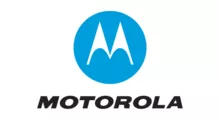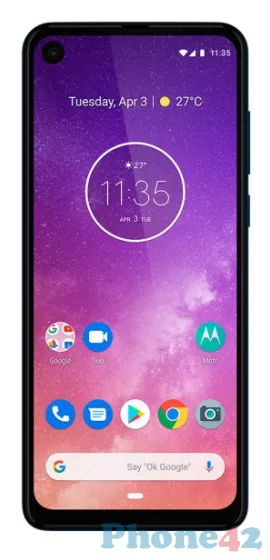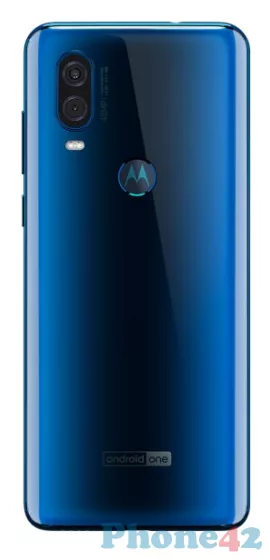
Motorola Moto One Vision (2019)
The manufacturer offers this phone with a 6.2 inch IPS display, a Exynos 7 Octa 9610 chipset, and 3 GB of RAM.
Navigate through its features, both the gems and quirks!
Table of Contents
- Motorola Moto One Vision specifications
- Weight, dimensions, colors
- System, chipset, performance
- Display type, size, resolution
- Memory, storage
- Cameras, flash
- Connectivity, network, wireless
- Battery type, capacity, charger
- Features, sensors, specials
- Verdict, pros and cons
This article shares our personal experiences and thoughts about using the Motorola Moto One Vision smartphone. We hope to offer helpful insights to others interested in this device.

Motorola Moto One Vision specifications
| Brand | Motorola |
|---|---|
| Name | Moto One Vision |
| Model | MOTOONEV |
| Release date | 2019 |
Weight, dimensions, colors
| Colors | black, brown, white |
|---|---|
| SIM type | Nano SIM |
Smartphones use a Nano SIM as a subscriber identity module (SIM), which is a chip card.
System, chipset, performance
| OS version | Android OS v9.0 (Pie) |
|---|---|
| SoC | Exynos 7 Octa 9610 |
| CPU | Octa-core, Quad-core 2.3 GHz Cortex-A73, Quad-core 1.6 GHz Cortex-A53 |
| GPU | Mali-G72 MP3 |
The Motorola Moto One Vision comes with Android OS v9.0 (Pie) out of the box. Android is an open-source operating system. This means users and developers have more control over the software. This octa-core CPU consists: Octa-core, Quad-core 2.3 GHz Cortex-A73, Quad-core 1.6 GHz Cortex-A53. Many people consider ARM Mali GPUs a good option for mobile devices.

Display type, size, resolution
| Display type | IPS |
|---|---|
| Screen size | 6.2 inch |
| Resolution | 1080 x 2520 px |
| Multitouch support | yes |
People know IPS for its wide viewing angles. It also has accurate color reproduction. The 6.2 inch display should be big enough for our needs. It will make viewing comfortable. This is true whether we're reading, browsing, or watching. The display size is the diagonal distance from one corner of the screen to the opposite corner.
Memory, storage
| RAM | 3 GB |
|---|---|
| Internal storage | 32 GB |
| Memory card slot | microSD |
The smartphone has 3 GB of RAM. It can run many apps at once without much lag or slowness. More RAM lets us keep more apps and processes open in the background. This keeps the device from slowing down. Generally, a smartphone should have a minimum of 32 GB of internal storage. The Moto One Vision has 32 GB. We can expand the internal storage of the Moto One Vision (32 GB) by using a compatible microSD card.

Cameras, flash
| Main camera | 48 + 5 MP, 8000 x 6000 px, autofocus |
|---|---|
| Flash | Dual LED |
| Selfie camera | 12 MP |
Using multiple cameras has advantages. They provide more versatility and creative possibilities. They let us capture a wider range of subjects. The main camera of Moto One Vision smartphone does not have OIS. The optical image stabilization (OIS) is an important feature in smartphones.
Connectivity, network, wireless
| GSM 2G bands | 850 / 900 / 1800 / 1900 |
|---|---|
| Network coverage | 2G / 3G / 4G |
| Wi-Fi | Wi-Fi 802.11 a/b/g/n |
| Bluetooth | v5.0, A2DP |
| GPS | A-GPS, GLONASS |
| NFC | yes |
| FM radio | yes |
| USB | USB Type-C |
| Headphone | 3.5 mm jack |
The 4G provides faster data transfer speeds compared to previous generations. The Moto One Vision supports the latest Wi-Fi standards. We can use Bluetooth to connect our Moto One Vision smartphone to many Bluetooth devices. The Moto One Vision has a GPS receiver. Many fitness and activity tracking apps rely on GPS. It is used to accurately measure and record outdoor activities. The Moto One Vision comes with NFC (Near Field Communication) functionality. The 3.5 mm headphone jack allows us to connect wired headphones or earphones to the device.
Battery type, capacity, charger
| Type | Li-Ion 3500 mAh, non-removable |
|---|
The Li-Ion 3500 mAh, non-removable battery gives the smartphone a good battery backup. The Li-ion is a low maintenance battery. It does not need periodic full discharge. The Moto One Vision does not have a removable battery, it integrates the battery into the phone's design.
Features, sensors, specials
| Sensors | accelerometer, compass, fingerprint, gyroscope, light, proximity |
|---|---|
| Specials | Corning Gorilla Glass, Fast charging, Water, AndroidOne |
Today, smartphones come with many sensors. They help make the user experience better. The accelerometer is a sensor. It measures the tilting motion and orientation of the phone. The fingerprint reader is a biometric security feature found in Moto One Vision smartphones. The light sensor is a type of sensor in a smartphone. It lets the phone measure light intensity around the device. With fast charging, we can get a significant amount of battery life in a few minutes of charging. Corning Gorilla Glass is tougher. It resists scratches, impacts, and drops.
Verdict, pros and cons
Every phone has its strengths and weaknesses, and this Motorola phone is no exception. As with any device, there are aspects that shine and others that fall short. By examining both sides, we can paint a complete picture of what this phone has to offer. Let's explore its standout features and areas for improvement. Remember, this is just my opinion, and yours might be different.
Pros
- appropriate screen size
- microSD slot
- multicamera setup
- Corning Gorilla Glass shield
Cons
- no OIS function
- no 5G support
- low-capacity battery
Please let us know if you find incorrect information or something isn't working. Also, tell us if you have a suggestion for improvement.
 I'm Lucas Bradley, the founder of the Phone42.com site. I love technology, especially smartphones, and I've been working with tech stuff for more than 20 years. This means I've seen a lot of changes and have learned a bunch about what makes a good phone. On Phone42.com, I look at all kinds of phones. They can be from big, well-known companies or new ones trying to make their mark. I want to help people understand what's new and cool in the world of smartphones, in a way that's easy to get.
I'm Lucas Bradley, the founder of the Phone42.com site. I love technology, especially smartphones, and I've been working with tech stuff for more than 20 years. This means I've seen a lot of changes and have learned a bunch about what makes a good phone. On Phone42.com, I look at all kinds of phones. They can be from big, well-known companies or new ones trying to make their mark. I want to help people understand what's new and cool in the world of smartphones, in a way that's easy to get.